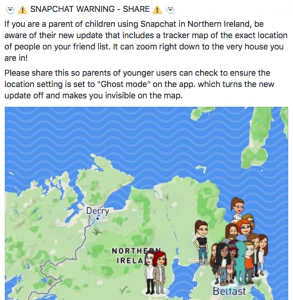
Snapchat – Snap Maps – What You Need To Know
Posted on: June 23, 2017
On Wednesday Snapchat announced their new feature ‘Snap Maps’ (See here). The feature allows users to share their location and to access a Snap Map and see which of their friends are nearby (or indeed where they are!). The launch video (on the above link) suggests that the aim of this is for people to see if their friends are nearby, see what they’re up to and potentially join in the fun.
Of course, as a result of this feature other social media sites are full of warnings to parents about Snap Maps such as the one below:

These posts are great for raising awareness but often take a scaremongering approach, encourage knee-jerk reactions to new features and don’t help parents (or those who work with teenagers) to actually think about how they can have conversations around privacy with young people.
This blog post will hopefully give you a better understanding of Snap Maps, any causes for concern that come with it, some positives and ways we can discuss this feature with young people.
Location sharing isn’t a new thing. WhatsApp and iMessage already allow you to share your location via a message, the social network FourSquare allows you to ‘check in’ to places (as does Facebook) and Apple’s ‘Find My Friends’ app has allowed users to share their location in real time with approved friends (other similar apps exist).
The difference is that sharing via a message/WhatsApp either shares your current location or your location for a set period of time and ‘Find My Friends’ is simply for sharing your location in real time and has no additional features. Snap Maps however shares your location, all the time, in real time as part of a social network.
So is the Snap Map something to be concerned about for the young people we work with?
Mostly yes and a little bit of no. Here’s why…
Mostly yes…
Snapchat is primarily popular with those aged 11-24 which means many of the young people we work with will be using Snapchat and will probably have the new feature. The feature in itself is only dangerous when young people don’t know the people they are friends with and therefore grant access to their location to strangers (or people who’s identities they can’t verify).
The ‘always on’ nature of the feature (although it can be switched off) means that it allows people to work out when people are home and away (potentially posing a security risk).
and No…
Young people take risks online but they’re also clued up, young people will know whether they’re comfortable with the new feature and probably already know how to switch it onto ghost mode.
It’s also not all bad. If young people use it in the way Snapchat seem to intend then it may lead to young people spending more time with each other…what if a young person snapchats your youth group, their friends think it looks cool and then, using Snap Maps turn up ten minutes later?
What can youth workers do?
If you know your youth group regularly use Snapchat then why not spend some time discussing it with them…you could ask them:
- Have you tried out the new Snap Maps? What do you think about it?
- What’s good about it?
- What’s not-so good about it?
- Imagine that someone younger than you comes to ask you about it. What advice would you give? (Perhaps come up with a top 3 tips)
You could talk to your young people about privacy and sharing their location along with knowing who they are friends with*
In addition to this you could encourage your group to think about when they might switch to ghost mode…perhaps the map feature only needs to be switched on when you’re doing something exciting. (Tutorial on how to switch to ghost mode on this site)
*This doesn’t always mean only people they know in real life…many young people’s friends are both online and offline friends and young people often don’t distinguish the difference between the two.
One final tip…
Rather than launching straight into a talk/discussion around Snap Maps maybe have a wider conversation around Snapchat…discuss what your groups favourite filters are at the moment?, what filters have gone they wish they could bring back?, if they could snapchat from anywhere in the world where would it be?
Further Reading
If you want to keep reading about being online and how to talk to young people about it then you should read ‘Raising Children in a Digital Age’ by Bex Lewis. Available here.
